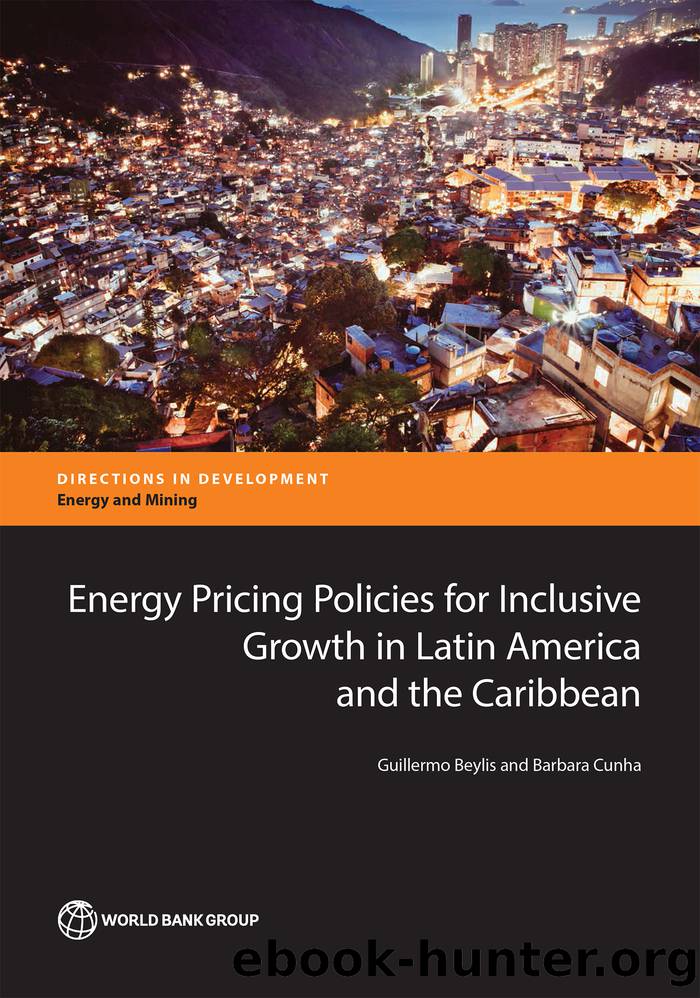Energy Pricing Policies for Inclusive Growth in Latin America and the Caribbean by Guillermo Beylis & Barbara Cunha

Author:Guillermo Beylis & Barbara Cunha
Language: eng
Format: epub
Methodology and Implementation
Any assessment of the distributional impact of removing subsidies and reforming energy pricing mechanisms must rely on an understanding of the consumption patterns of householdsânot only the direct consumption of energy products (such as buying gasoline for oneâs car or paying an electricity bill), but also the indirect consumption of energy products, which may be even more important. As highlighted in chapter 4, many of the final goods consumed by households have energy embedded in them. Therefore, changes in energy prices will translate into changes in production costs, with industries that are energy-intensive affected the most. As a result, to correctly identify the distributional impact of changing energy prices, one has to assess two distinct effects: the distributional effects of the direct consumption of energy products and the indirect effects of changes in the prices of all other consumer goods that have energy embedded in them.
For the purposes of our analysis, we adopt a methodology that has become standard for assessing the distributional impact of subsidy reform (see, among others, Coady and Newhouse 2006; Coady et al. 2006; Kpodar 2006). This methodology relies on estimating a monetary measure of compensation that would leave households indifferent to facing low (before the price change) or high (after the price change) energy prices. In short, we estimate the amount of money that if offered to households would leave them indifferent between the two levels of price.
The proposed methodology allows us to clearly disentangle the direct and indirect effects. Moreover, it is relatively straightforward to implement and easy to understand. For the analysis, there are essentially two data requirements, an input-output (IO) matrix of the economy and a household expenditure survey. The IO matrix depicts the connection between sectors of the economy, showing how any one sector is both a supplier of inputs and a buyer of outputs from other industries. The IO matrix is used with two purposes: (1) to identify how increases in costs resulting from increases in energy prices will propagate throughout the economy; and (2) to ascertain how much the prices of final consumer goods will rise. We use household expenditure surveys to describe the consumption baskets across the expenditure distribution, allowing for the distinction between direct expenditures on energy products and expenditures on all other consumer goods.
The analysis is developed in three stages. The first stage assesses the magnitude of the direct effect, which is estimated by multiplying the share of a householdâs budget allocated to a particular energy product by the percentage price increase of that energy product. The second stage calculates in two steps the magnitude of the indirect effect: (1) the change in prices of all goods and services (excluding energy products) consumed by households is estimated using IO matrixes (as described in the previous chapter); and (2) the indirect effect is obtained by multiplying the shares of a householdâs budget devoted to the various goods and services by the estimated percentage price increase in each of these goods and services. Finally, the total welfare effect on a household is calculated as the sum of both effects.
Download
This site does not store any files on its server. We only index and link to content provided by other sites. Please contact the content providers to delete copyright contents if any and email us, we'll remove relevant links or contents immediately.
Life 3.0: Being Human in the Age of Artificial Intelligence by Tegmark Max(5474)
The Sports Rules Book by Human Kinetics(4294)
The Age of Surveillance Capitalism by Shoshana Zuboff(4210)
ACT Math For Dummies by Zegarelli Mark(3996)
Unlabel: Selling You Without Selling Out by Marc Ecko(3589)
Blood, Sweat, and Pixels by Jason Schreier(3566)
Hidden Persuasion: 33 psychological influence techniques in advertising by Marc Andrews & Matthijs van Leeuwen & Rick van Baaren(3472)
The Pixar Touch by David A. Price(3364)
Bad Pharma by Ben Goldacre(3357)
Urban Outlaw by Magnus Walker(3342)
Project Animal Farm: An Accidental Journey into the Secret World of Farming and the Truth About Our Food by Sonia Faruqi(3178)
Kitchen confidential by Anthony Bourdain(3009)
Brotopia by Emily Chang(3001)
Slugfest by Reed Tucker(2942)
The Content Trap by Bharat Anand(2863)
The Airbnb Story by Leigh Gallagher(2799)
Coffee for One by KJ Fallon(2566)
Smuggler's Cove: Exotic Cocktails, Rum, and the Cult of Tiki by Martin Cate & Rebecca Cate(2471)
Beer is proof God loves us by Charles W. Bamforth(2371)
